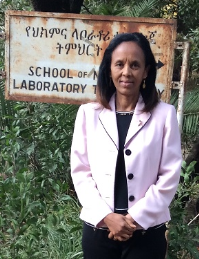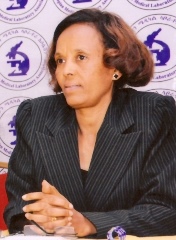One of the grantees from TDR’s women in science initiative has been able to leverage her small project in Ethiopia into something much larger. Find out more about the determined Aster Tsegaye. On her morning walks to school in Harar, an ancient, hilltop city in the rugged eastern region of Ethiopia, Aster Tsegaye frequently stopped to consider the victims of leprosy begging by the roadside, flies swarming the open wounds on their hands and feet. “I was so sympathetic to those people,” she said, recalling the moment she first started down the path to becoming a doctor, more than 40 years ago. “It was in grade 4. My Amharic teacher asked us what we wanted to be – I said I should be a nurse so I can treat these people.” |  Dr Aster Tsegaye |
Tsegaye had always understood, she said, that “males are called doctors and females are called nurses.” When her teacher explained that women could be doctors, too, Tsegaye was taken aback. “I had never seen one before,” she said. “All the doctors I knew were men. And my teacher said to me: ‘If you want to be a clinician, why don’t you become a doctor?’”.
Thus began her journey – from the far east of the country to the capital, 500 kilometres away; from the classroom to the laboratory to a series of leadership positions in a field where female professionals are scarce. “Globally, there are very few women scientists who are advancing to the highest levels,” she says, and Ethiopia is no exception. “In primary school, it isn’t a problem – it is half and half. But as you go higher, you find fewer and fewer women. The pipeline is leaking, and it leaks most at the top.”
Establishing a foundation to help women
Several years ago, Tsegaye, now an associate professor of immunology at Medical Laboratory School in the College of Health Sciences at Addis Ababa University and a Fellow of the Ethiopian Academy of Sciences, decided to do something to stem that leak. With the initiation and support from the Ministry of Science and Technology (MOST), she helped found the Society of Ethiopian Women in Science and Technology, or SEWiST.
Globally, there are very few women scientists who are advancing to the highest levels. The pipeline is leaking, and it leaks most at the top.
A veteran scientist, Tsegaye has more than 25 years of experience in clinical laboratory diagnostic services, and nearly 40 publications to her name, among them two judged the “best scientific paper of the year” – one by the Ethiopian Medical Association and one by her college.
Through SEWiST, Tsegaye has been able to use her experience to help early-career female scientists make their way in a male-dominated world. In 2013, she was tapped to serve as the society’s vice president, and began to search for new sources of support. “And that’s when I came across the TDR call for letters of interest from women scientists on ideas for improving career development for women research scientists working in infectious diseases,” she says. “I decided right away that I had to apply.”
Training for women that leads to something bigger
With some US$ 10 000 in TDR support, Tsegaye organized a five-day workshop designed to encourage female researchers in infectious diseases through training, mentoring, role modelling and networking. In all, 31 women scientists from five academic institutions took part in the workshop. “The training covered things as simple as establishing the sample size and drafting a grant proposal to striking a balance between work and family life,” says Tsegaye, herself a mother of three, who served as a role model to the early-career participants.
 Dr Aster Tsegaye | “We are in a society where nobody trusts that women can do it,” she says. “It’s so challenging here. There’s the family burden, the social burden, and of course one’s career. Maybe it’s the way I was raised in the eastern part of Ethiopia,” where she says women are able to speak up for themselves. “When I face a challenge, I always find a way. I’m the kind of person who never gives up.” |
To Tsegaye, who had logged countless hours teaching and conducting laboratory research at Ethiopia’s largest referral hospital, the shortage of quality control materials in labs around the country was of paramount importance. Most clinical decisions are based on laboratory results, yet due to the cost, the difficulty of transporting perishable products across the country, and the short half-life of whole blood, most medical laboratories in Ethiopia find it difficult to continuously run quality control materials.
“Without a strong laboratory with good quality control, you cannot support diagnosis and monitoring of infectious diseases,” Tsegaye explains. “So this project will investigate the use of alternative quality control methods, such as Retained Patient blood for haematology and pooled human sera and Bovine sera for clinical chemistry tests.” But the first challenge, she says, “is to establish our own reference interval,” the clinical laboratory parameters for a physiologic measurement in healthy persons.
“To find those healthy Ethiopians, we will collect 14 000 biological samples, and screen them for viral infections, intestinal and hemoparasites,” says Tsegaye. Since Ethiopia’s population is heterogeneous, collection will be carried out by regional and university laboratories around the country under the coordination of the Ethiopian Medical Laboratory Association (EMLA). Results of the study will dictate the type of quality control material and reference interval used in all health facilities across Ethiopia – from Addis Ababa to far away Harar, where years ago a little girl named Aster dared to dream that she might one day be a doctor.
Dr Workenesh Ayele, a virologist with Ethiopia’s National Influenza Laboratory who co-led the TDR-supported workshop for women, recalls how quickly her longtime friend and colleague made her mark on her home institution. “Right away, she captured
the attention of her new colleagues by her positive outlook and characteristic way of throwing herself unreservedly into her work, with enthusiasm and total dedication,” she says. “Dr Aster is an outstanding and exemplary teacher and a
good role model who pushes her students to aspire to greater heights while lending them every possible support within her means.”
For more information, contact:
Makiko Kitamura
TDR Communications Officer
Telephone: +41 22 791 2926
email: kitamuram@who.int

